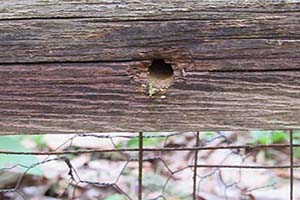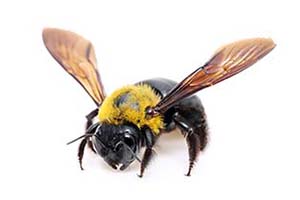Carpenter Bees, The Buzz Isn't an Electric Drill
Carpenter Bees, The Buzz Isn't an Electric Drill
By Bill Willis and John McLamb
July 5, 2018

Photo courtesy of Bill Willis
Most of us know what a Carpenter Bee looks like - a bumblebee and we leave them alone. They are solitary bees that construct tunnels in wood or wooden structures, unlike the leafcutter and Orchard Mason bees that adopt pre-existing cavities. The problem arises when they choose your property, especially porches and deck rails, in which to place half-inch holes.
It’s not that they are losing their habitat to human activities; it’s the availability of wooden structures.
Xylocopa virginica is the most common native carpenter bee in eastern United States followed by Xylocopa micans. These bees have all black shiny abdomens. Being hairless on top, distinguishes them from bumblebees. The male has a white dot on his head, but he doesn’t drill or sting. His role is to mate with emerging females.
The female chews out the wood to make a home for her offspring, preferring soft woods like pine and popular but might use most tree species. You’ll see a pile of sawdust, usually from the underside of a board, before noticing the hole. The tunnel can be from six to eighteen inches long with radiating side shoots, but it only has one opening.

Photo courtesy of Bill Willis
The female lays her eggs in the shafts by first making a ball of pollen, laying a single egg, then sealing that space with the sawdust, thereby, creating a particleboard partition. This action is repeated multiple times. Eggs will hatch; larvae feed, growing on pollen, pupate, and emerge in the fall. Like other cavity dwelling bees, the males emerge first and they wait for the females to show up. Females will overwinter in the tunnels after cleaning them out.
What can you do if faced with damage? Plug up their hole with caulk when the female leaves; replace railings with plastic material; build a lure, such as a wooden fence, shed, or bench to encourage them to move elsewhere. A coating of polyurethane, stain, or paint is said to be a deterrent.
Carpenter bees are good pollinators of garden vegetables like tomatoes, eggplants, and cucumbers as well as companion herbs. In some countries, these bees are even raised to pollinate vegetables. Although they can be destructive at times, they can have a positive role in the small urban garden.





